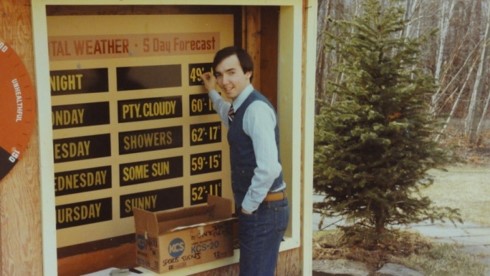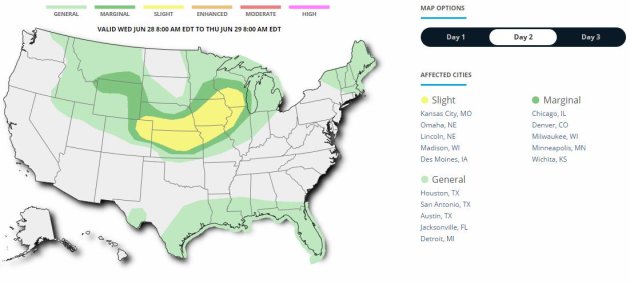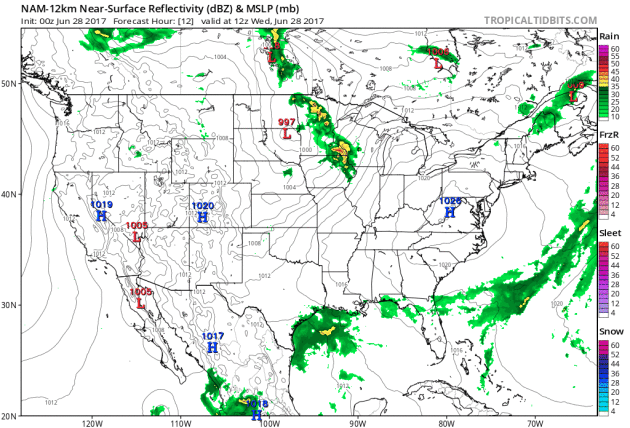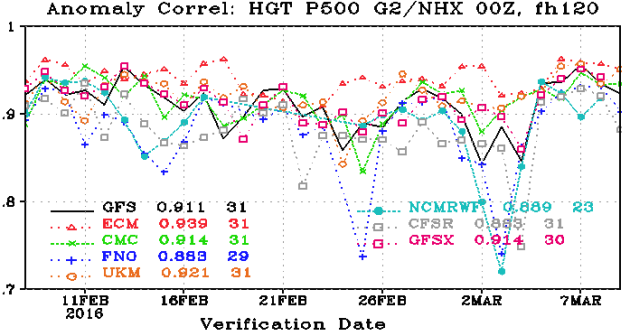82 F. average high on June 27.
76 F. high on June 27, 2016.
June 28, 1876: The latest ice breakup in history for Duluth occurs on Lake Superior.

Wednesday Super-Soaker, Promising 4th of July
What keeps me up at night? An EF-4 tornado striking with no warning. A Category 5 hurricane plowing into Miami or Charleston. Forecasting "flurries", only to wake up to a foot of snow. Busting the 4th of July forecast. Not necessarily in that order.
You see, people have long memories, especially over blown summer weekend forecasts, notably the 4th of July, when people flee to their favorite lake.
I'm still reminded of a forecast I made in 1976. I predicted sprinkles. It POURED for 8 hours on the 4th of July. Not. Good.
With all necessary disclaimers in place, I'm cautiously optimistic about the holiday weather. Saturday will be cool with a northwest breeze and a slight shower risk. But models take most of the storms just south of Minnesota Sunday and Monday, leaving us partly sunny with highs in the 70s. A little cool for the lake, but it could be far worse. By Tuesday temperatures nudge 80F, with humidity levels that will make you want to go jump in a lake. Go for it.
Today looks super-soggy with nearly an inch of rain and a slight severe T-storm risk for southeastern Minnesota and southwest Wisconsin. Long-range models still hint at a stinking-hot July.
* Photo above is from 1980, when I was working at WNEP-TV in Wilkes-Barre/Scranton, home of the original "back yard" weather format. My first TV News Director (Jay Newman) showed me the outdoor set and said "Paul, if you're standing out here at least you'll get the current weather right."



Image credit: "The latest verification, in this case the global 5-day forecasts at 500 hPa, shows the European Center (red triangles) to be consistently superior than the U.S. GFS (black line)."
UCAR Collaboration With the Weather Company to Improve Weather Forecasts Worldwide. Here's more information on how UCAR is teaming with IBM to try and improve the state of the art when it comes to weather modeling: " The University Corporation for Atmospheric Research (UCAR) today announced a new collaboration with The Weather Company, an IBM business, to improve global weather forecasting. The partnership brings together cutting-edge computer modeling developed at the National Center for Atmospheric Research (NCAR) with The Weather Company's meteorological science and IBM's advanced compute equipment. "This is a major public-private partnership that will advance weather prediction and generate significant benefits for businesses making critical decisions based on weather forecasts," said UCAR President Antonio J. Busalacchi. "We are gratified that taxpayer investments in the development of weather models are now helping U.S. industries compete in the global marketplace..."
Image credit: "The Model for Prediction Across Scales (MPAS) enables forecasters to combine a global view of the atmosphere with a higher-resolution view of a particular region, such as North America." UCAR.
A New Supercomputer-Powered Weather Model May Be Ready for Exascale. Here are a couple of excerpts from a post by Jim Sexton at IBM: "In the U.S. alone, extreme weather caused some 297 deaths and $53.5 billion in economic damage in 2016. Globally, natural disasters caused $175 billion in damage. It’s essential for governments, business and people to receive advance warning of wild weather in order to minimize its impact, yet today the information we get is limited. Current global weather forecast models can predict weather patterns down to regional-scale weather events, such as snowstorms and hurricanes, but lack the ability to predict more local phenomena such as thunderstorms...That’s why IBM Research, The Weather Company, the University Corporation for Atmospheric Research (UCAR) and the National Center for Atmospheric Research (NCAR) are collaborating to develop the first rapidly-updating, storm-scale model that can help predict weather events such as thunderstorms at local scales..."
Image credit: "IBM Research, The Weather Company and NCAR aim to use supercomputing to enable short-term thunderstorm forecasts as well as more accurate long-range forecasts days, weeks and months in advance." (Credit: Shutterstock).
The Southwest is Burning. Check out the trends, according to High Country News and Grist: "...Nationally, wildfires have consumed more than 2.5 million acres of land so far this year. In the past decade, more acreage burned by this point only once, in 2011. That year, unusually hot, dry conditions led to several large conflagrations, including New Mexico’s Las Conchas Fire and Arizona’s Wallow Fire..."
Graphic credit: "The line traces the fire acreage; the labels show the number of fires per year." Keith Halloran/U.S. Forest Service.
Frequency of Billion Dollar U.S. Weather and Climate Disasters. Here's an excerpt from NOAA NCEI: "...NCEI is the Nation's scorekeeper in terms of addressing severe weather and climate events in their historical perspective. As part of our responsibility to monitor and assess the climate, we maintain a record of the weather and climate events that have had the greatest economic impact from 1980 to 2017. The United States has sustained 208 weather and climate disasters since 1980 where overall damages reached or exceeded $1 billion (including CPI adjustment to 2017). The total cost of these 208 events exceeds $1.1 trillion..."
Graphic credit: NOAA NCEI: "Event statistics are added according to the date on which they ended. Statistics valid as of April 6, 2017."
U.S. Mayors Back 100% Renewable Energy, Vow to Fill Climate Leadership Void. InsideClimate News has the story: "As
the nation's mayors closed their annual meeting on Monday in Miami
Beach, they sent a clear signal that cities are looking for action on climate change and are eager to fill a policy gap created by the Trump administration. The United States Conference of Mayors,
which includes both Republican and Democratic mayors from cities across
the nation, adopted a series of resolutions that are far more assertive
than federal climate policy, including a pledge supporting cities' adoption of 100 percent renewable energy by 2035.
"We are showing the world that cities and mayors can and will lead the
transition away from fossil fuels to 100 percent clean, renewable
energy," said Columbia, South Carolina, Mayor Steve Benjamin, a
co-sponsor of the resolution, in a statement..."
Is Your Job About to Disappear? Quick Take.
Nearly every industry and profession is being disrupted by
globalization, automation and AI, some faster than others, according to a
story at Bloomberg: "Thirteen years ago, two prominent U.S. economists
wrote that driverless cars couldn’t execute a left turn against
oncoming traffic because too many factors were involved. Six years
later, Google
proved it could make fully autonomous cars, threatening the livelihoods
of millions of truck and taxi drivers. Throughout much of the developed
world, gainful employment is seen as almost a fundamental right. But
what if, in the not-too-distant future, there won’t be enough jobs to go
around? That’s what some economists think will happen as robots and
artificial intelligence increasingly become capable of performing human
tasks. Of course, past technological upheavals created more jobs than
they destroyed. But some labor experts argue that this time could be
different: Technology is replacing human brains as well as brawn..."
Data: Frey & Osborne, Bureau of Labor Statistics.
Illustration credit: Daniel Hertzberg.
All the Animals That Love Touchscreens. My dog (Leo) loves watching YouTube videos of other dogs (howling). Who knew? Here's a clip from Atlas Obscura: "...It’s
really simple—if the animal knows how to use a screen, you can modify
the symbols and change the tasks,” she says. It also makes for eager
study subjects, some of whom have truly internalized their training.
“Some animals love the touchscreen so much that it seems they don’t
really care what happens,” says Oberliessen. “Sometimes they don’t even
take the reward.” They wait eagerly for their turns with the machines,
and if a certain wolf or dog isn’t scheduled to use one on a particular
day, “they seem disappointed,” she says. “They look like [they’re
asking], ‘I’m not being tested? Why!?..."
Photo credit: "Penguins crowd around an iPad game at the Aquarium of the Pacific." Sara Mandel/Aquarium of the Pacific
Guy Stands Uncomfortably Close to a Tornado (and Films).
This was from the tornado that hit south Jersey last Saturday. I would
probably be doing the same thing (trying to video this with my
smartphone) but it's probably the smartest move. Video clip courtesy of theCHIVE.
TODAY: Heavy rain and storms likely. Winds: S 10-20. High: 78
WEDNESDAY NIGHT: Showers taper. Low: 62
THURSDAY: Partly sunny and drier. Winds: NW 5-10. High: near 80
FRIDAY: More showers arrive. Sloppy. Winds: NW 10-15. Wake-up: 61. High: 73
SATURDAY: Mostly cloudy and cool. Stray shower possible. Winds: NW 8-13. Wake-up: 59. High: 71
SUNDAY: Partly sunny, a brighter, better day. Winds: NW 7-12. Wake-up: 58. High: 77
MONDAY: Mix of clouds and sun, probably dry. Winds: NE 5-10. Wake-up: 59. High: 79
4TH OF JULY: Intervals of lukewarm sunshine. Winds: SE 5-10. Wake-up: 62. High: 82
Climate Stories...
Phoenix Heat, Tropical Storm Cindy Show How Climate Change is a Threat To Our Infrastructure. Details via an Op-Ed at The Washington Post: "Much of the Southwestern United States is reeling under a heat wave so severe that it has forced airlines to ground flights. On the Gulf Coast, millions of people were put on emergency alert ahead of Tropical Storm Cindy, which caused widespread flooding and power outages. Climate change is already affecting our economy and safety, with risks to critical infrastructure — roads, bridges, dams, water and energy infrastructure and military sites. The nation’s infrastructure is already in a precarious state, consistently earning a near-failing grade of D-plus from the American Society of Civil Engineers. Much of it was built assuming past climate and weather patterns, with some margin of safety. But now, climate change — in the form of more frequent and severe heat waves; floods exacerbated by sea-level rise and increased heavy rainfall; droughts; wildfires; and other impacts — is adding an extra layer of risk..."
Photo credit: "Planes sit on the tarmac at Phoenix Sky Harbor International Airport. American Airlines says seven regional flights have been delayed and 43 have been canceled because of a heat wave as temperatures climb to near-record highs on Tuesday." (Ross D. Franklin/Associated Press).
Will Climate Change Make Severe Weather Like the Recent Hailstorms the Norm in Colorado? The data is still inconclusive, but it's worth watching the trends, according to a post at Colorado Public Radio: "The hailstorm that struck the Denver metro area last month was the costliest natural catastrophe in state history, with more than $1 billion in losses, according to the Rocky Mountain Insurance Information Association. That's not the only recent example of severe weather in Colorado, what with record-setting heat being recorded in the last couple of weeks. Is this becoming the norm, and how much of it might be attributed to climate change? From wildfires to changes to the state's national parks, all around us there are examples of how an evolving environment is impacting life here. Those changes can been seen throughout the calendar, from the vineyards that yield summer wines, to the winter ski season..."
Photo credit: "Patrick Clark inspects his damaged car after a strong spring storm moved through the metropolitan Denver area Monday afternoon, May 8, 2017." AP Photo - P. Solomon Banda.
Bigger Hail Might Pummel the U.S. as Climate Change Gathers More Force. The Verge has more perspective on the dynamics in play: "...A study published today in Nature Climate Change shows that in the second half of this century, North America could experience fewer hail days overall, but storms with larger hail might become more common, including hail that’s larger than 1.6 inches — exactly like the hailstorm that plummeted Denver. This is bad news across the board: hail can destroy crops, as well as homes and cars, leading to more insurance losses. Predicting how hail will change due to global warming is very complicated. Hail forms during thunderstorms, when fast air currents carry water droplets up in the sky, where they freeze into hailstones. As more water freezes around them, these lumps of ice become too heavy and fall onto the ground as hail..."
Photo credit: "
Map credit: "Antarctic sea ice concentration relative to 1981-2000 normal, June 25, 2017." (National Snow and Ice Data Center).
Global Sea Level Rise Accelerates Since 1990, Study Shows. This will become non-trivial for anyone living on or near the coast, according to a story at Reuters: "The rise in global sea levels has accelerated since the 1990s amid rising temperatures, with a thaw of Greenland's ice sheet pouring ever more water into the oceans, scientists said on Monday. The annual rate of sea level rise increased to 3.3 millimeters (0.13 inch) in 2014 - a rate of 33 centimeters (13 inches) if kept unchanged for a century - from 2.2 mm in 1993, according to a team of scientists in China, Australia and the United States. Sea levels have risen by about 20 cms in the past century and many scientific studies project a steady acceleration this century as man-made global warming melts more ice on land..."
File image: Skeptical Science.
How Climate Change Will Transform the Way We Live. Fortune has a summary of new research into the implications of consistently hotter summers: "...According to a study co-authored by Mora, if carbon emissions aren’t reduced, by 2100 New York City will experience about 50 days per year of heat and humidity conditions that has resulted in death (up from about two days now). Meanwhile, in cities such as Orlando and Houston, this threshold will be crossed for the entire summer, making it unsafe to go outside for extended periods of time. “We’ll become prisoners of our houses,” says Mora. In this brutally hot version of the future, in many U.S. cities air conditioning will become a literal life saver. Power outages, like the one that swept through Northeast and the Midwest in 2003 -- leaving 50 million people without electricity—will no longer be an inconvenience, but a national emergency..."
Wall Street Is Starting to Care About Climate Change. As always, follow the money. Here's an excerpt from Axios: "A record number of investors are pressuring fossil-fuel companies to reveal how climate change could hit their bottom lines. Efforts by shareholders to push resolutions on the risk related to carbon regulations are reaching a tipping point, with almost half of investors in fossil-fuel and utility companies backing resolutions, according to a new analysis by nonprofit group Ceres not yet published publicly. Activist shareholders of publicly traded companies have been pushing resolutions on climate change for years and now the effort is going mainstream with new support from institutional investors..."
Illustration credit: Rebecca Zisser / Axios.
How Climate Change Helped Lyme Disease Invade America. Another unintended consequence of a warming climate; details from Vox: "...Walter
studies Lyme disease, the tick-borne illness that’s spreading
frighteningly quickly in the Eastern and Midwestern US, due in part to
climate change. Lyme cases have more than doubled since the 1990s, and
the number of counties that are now deemed high-risk
for Lyme has increased by more than 320 percent in the same period.
2017 is also shaping up to be a particularly bad year for Lyme. “These
effects of climate change will be felt globally, but also here in the
US,” Walter said, “and here in New York, in Trump’s backyard.” New York
state is an epicenter for Lyme. More than 90 percent of cases in the
Northeast, upper Midwest, and mid-Atlantic. And it’s why New York Sen.
Chuck Schumer has been calling on the federal government to more aggressively tackle Lyme..."
How to Tell If Your Reps Are Serious About Climate Change. Here's a clip from a RollingStone article: "...Happily, the other three-quarters of the labor movement has increasingly sided with the communities fighting against climate change, in part because it's obvious that renewable energy will supply the jobs of the future. As Naomi Klein wrote in The New York Times, "Today labor leaders face a clear choice:" Back bogus pipelines or "join the diverse and growing movement that is confronting Mr. Trump's agenda on every front and attempt to lead America's workers to a clean and safe future." For politicians, that choice is even clearer- – and some have responded. Portland, Oregon, for instance, recently banned any new fossil-fuel infrastructure. Philadelphia has plans to become a fossil-fuel "hub" for the Atlantic seaboard, but a broad coalition of scientists and community groups is putting up a stiff fight..."
Photo credit: Kayana Szymczak/The New York Times/Redux.
No comments:
Post a Comment